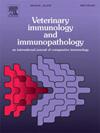A simplified vaccination program elicits an immune response comparable to a complex standard vaccination program in commercial layers under field conditions
IF 1.4
3区 农林科学
Q4 IMMUNOLOGY
引用次数: 0
Abstract
Newcastle disease (ND) is a notifiable avian disease responsible for several panzootics, which has resulted in the establishment of mandatory vaccination programs against the virus in several countries including Denmark. This study compared the immune response elicited in layers by the standard vaccination program for ND of a Danish commercial egg production facility with a simplified version of the vaccination program. A commercial flock of layers was followed for 77 weeks from hatching to culling. The flock was divided into two groups according to vaccination program and housed separately. One group received the standard vaccination program consisting of a vector vaccine, a live vaccine (administered twice) and an inactivated vaccine (standard vaccination program). The other group received a newly marketed vector vaccine and the inactivated vaccine of the standard vaccination program (simplified vaccination program). Blood samples were collected at regular intervals from 30 randomly selected layers in each group until culling (77 weeks of age) and analysed for ND antibodies by ELISA assays, which measured antibodies against the nucleoprotein or fusion protein, and hemagglutination inhibition tests. Both vaccination programs provided lasting antibodies until 77 weeks. The simplified vaccination program showed significantly higher fusion protein antibodies and a markedly earlier onset of immunity at five weeks of age (97–100 % seroprevalence) than the standard program. The standard vaccination program reached the same seroprevalence at 14 and 24 weeks of age based on fusion protein antibodies and HI titres, respectively. The inactivated vaccine elicited a boost in antibody titres in both groups, however, boosting with the live vaccine used in the standard vaccination program did not result in an increased antibody response. This might indicate that administering of a vector vaccine prior to a live vaccine inhibits the serological response to the live vaccine.
在野外条件下,简化的疫苗接种程序所引起的免疫反应可与商业层中复杂的标准疫苗接种程序相媲美。
新城疫(ND)是一种应通报的禽类疾病,导致了几次大流行,这导致包括丹麦在内的几个国家建立了针对该病毒的强制性疫苗接种计划。本研究比较了丹麦商业鸡蛋生产设施的标准ND疫苗接种程序与简化版本的疫苗接种程序在蛋鸡中引起的免疫反应。从孵化到淘汰,对一群商业蛋鸡进行了77周的跟踪研究。根据接种计划将鸡群分为两组,分别饲养。一组接受标准疫苗接种计划,包括载体疫苗、活疫苗(注射两次)和灭活疫苗(标准疫苗接种计划)。另一组接种新上市载体疫苗和标准疫苗接种方案(简化疫苗接种方案)灭活疫苗。每组随机选择30只蛋鸡,定期采集血液样本,直到剔除(77周龄),并通过ELISA测定抗核蛋白或融合蛋白的抗体和血凝抑制试验分析ND抗体。两种疫苗接种计划都能提供持续抗体,直到77周。与标准接种方案相比,简化接种方案显示融合蛋白抗体显著增加,5周龄时免疫发作明显提前(97-100 %血清阳性率)。根据融合蛋白抗体和HI滴度,标准疫苗接种方案分别在14周龄和24周龄达到相同的血清阳性率。灭活疫苗在两组中引起抗体滴度的增强,然而,在标准疫苗接种计划中使用的活疫苗增强并没有导致抗体反应的增加。这可能表明,在活疫苗之前施用载体疫苗可抑制对活疫苗的血清学反应。
本文章由计算机程序翻译,如有差异,请以英文原文为准。
求助全文
约1分钟内获得全文
求助全文
来源期刊
CiteScore
3.40
自引率
5.60%
发文量
79
审稿时长
70 days
期刊介绍:
The journal reports basic, comparative and clinical immunology as they pertain to the animal species designated here: livestock, poultry, and fish species that are major food animals and companion animals such as cats, dogs, horses and camels, and wildlife species that act as reservoirs for food, companion or human infectious diseases, or as models for human disease.
Rodent models of infectious diseases that are of importance in the animal species indicated above,when the disease requires a level of containment that is not readily available for larger animal experimentation (ABSL3), will be considered. Papers on rabbits, lizards, guinea pigs, badgers, armadillos, elephants, antelope, and buffalo will be reviewed if the research advances our fundamental understanding of immunology, or if they act as a reservoir of infectious disease for the primary animal species designated above, or for humans. Manuscripts employing other species will be reviewed if justified as fitting into the categories above.
The following topics are appropriate: biology of cells and mechanisms of the immune system, immunochemistry, immunodeficiencies, immunodiagnosis, immunogenetics, immunopathology, immunology of infectious disease and tumors, immunoprophylaxis including vaccine development and delivery, immunological aspects of pregnancy including passive immunity, autoimmuity, neuroimmunology, and transplanatation immunology. Manuscripts that describe new genes and development of tools such as monoclonal antibodies are also of interest when part of a larger biological study. Studies employing extracts or constituents (plant extracts, feed additives or microbiome) must be sufficiently defined to be reproduced in other laboratories and also provide evidence for possible mechanisms and not simply show an effect on the immune system.

 求助内容:
求助内容: 应助结果提醒方式:
应助结果提醒方式:


